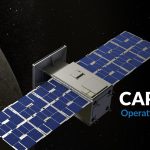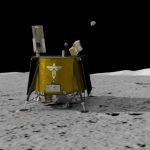As international space agencies work to develop lunar PNT capabilities, exploration efforts have become more diverse and collaborative than ever before. The Moon is now an international exploration priority, with GNSS critical to lunar PNT development.
In January, Inside GNSS and Inside Unmanned Systems will present a groundbreaking webinar to explore how leading-edge PNT capabilities are being brought to the Moon, featuring updates from four leading lunar navigation experts: Joel Parker, Flight Dynamics Engineer at the NASA Goddard Space Flight Center; Floor Melman, Radio Navigation Engineer, Radio Navigation Systems and Techniques Section for the European Space Agency/ESTEC; Masaya Murata, Japan Aerospace Exploration Agency (JAXA); and Ricardo Verdeguer, Product Line Manager, Defence & Space for Spirent Communications, a leading provider of GNSS simulation and testing solutions.
The webinar, “Lunar Navigation Services: A Global View from the Next Frontier,” sponsored by Spirent, is set for January 17 at 11 a.m. EST. The panelists will offer in-depth presentations on early lunar communications and navigation architecture concepts, current lunar communications and navigation system proposals, signal reception in the GNSS Space Service Volume (SSV) and the current roadmap for lunar navigation services.
Parker’s presentation, NASA PNT Priorities to the Moon and Beyond, will detail the meaningful role GNSS is playing in lunar PNT and the importance of ensuring the capabilities developed are interoperable, compatible and available to everyone. Various lunar PNT challenges and why fault tolerant autonomous systems are a must for lunar navigation will be part of the discussion.
Parker will give attendees an update on the phased expansion of lunar PNT, the U.S. missions using GPS in the Space Service Volume (SSV) today, and where we are with NASA’s Lunar GNSS Receiver Experiment (LuGRE) and ESA’s Lunar Pathfinder, both key evolutionary milestones for lunar PNT. He’ll take a look at various lunar navigation communication systems concepts including NASA’s Lunar Communications Relay and Navigation Services (LCRNS), ESA’s Moonlight, JAXA’s LNSS and China’s Queqiao. The Initial LunaNet PNT System of Systems, the Lunar Augmented Navigation Service (LANS), will consist of LCRNS, Moonlight and LNSS. LunaNet is a lunar communications and navigation architecture concept with a framework of standards for open, interoperable networks. The LANS PNT concept will be provided by LunaNet nodes.
Melman’s talk will focus on European Navigation on the Moon. He’ll detail ESA’s PNT roadmap for lunar navigation services, which includes Earth-based GNSS leveraging high-sensitivity GNSS receivers in phase one and Moonlight, a dedicated initial lunar orbit GNSS-like constellation that will provide South Pole surface and cislunar orbit services, in phases two and three. An overview of the upcoming Lunar Pathfinder in-orbit payload demonstration and its significance is also on the agenda. It will be the first demonstration of GNSS reception on lunar orbit.
Murata’s presentation, Shedding Light on JAXA’s Pioneering Advancements in GNSS, will detail what it takes to establish a LANS, or Moon GNSS. He’ll provide an overview of LNSS, the GPS-like satellite constellation JAXA developed for Moon navigation and its contribution toward LANS. He’ll also outline JAXA’s collaboration with ESA and NASA on the LunaNet Interoperability Specification (LNIS).
ESA, JAXA and NASA are preparing for a LANS interoperability demonstration mission in 2028, which Murata will detail.
Verdeguer will end the webinar with “Spirent Communications: Showcasing how Spirent is Taking PNT to the Moon, giving attendees a look at Spirent’s critical role in advancing lunar navigation and the many complex simulation challenges — and solutions, that are enabling the lunar navigation and the commercialization of space.
Click here to register for this can’t miss webinar, which is scheduled for 11 a.m. Eastern on January 17.






